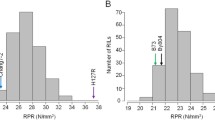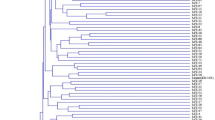Abstract
The pink stem borer (Sesamia nonagrioides Lefèvbre) is the most important pest of maize (Zea mays L.) throughout the Mediterranean area. The maize composite EPS12 has been chosen as the base population for a breeding program based on its resistance to pink stem borer, with the main selection criterion being resistance to stem tunneling. Yield was taken as a secondary selection criterion to avoid any unwanted negatively correlated response on this character. The aims of investigation were: (1) to monitor the effects of selection for resistance to pink stem borer on allele frequency at 70 simple sequence repeat (SSR) markers and their impact on the genetic structure of EPS12 and (2) to identify loci at which allelic frequencies changed significantly due to directional selection. Genetic diversity was reduced during the selection process (as expected since random genetic drift as well as selection could reduce genetic variability), but not significantly so. Although the loss of genetic variation was generally consistent with that expected in a model in which random genetic drift acts alone on neutral alleles, the changes observed in the frequency of five alleles were significantly greater than expected. Further, the linear trend of the departure from the random genetic drift model was significant for some allelic versions of two SSR markers, umc1329 and phi076; directional selection was therefore acting on these loci. The significant effect of directional selection on those markers suggests the presence of quantitative trait loci (QTLs) for tunnel length and/or for yield under artificial infestation with Sesamia nonagrioides on the long arm of chromosome 4.
Similar content being viewed by others
References
Ajmone Marsan P, Gorni C, Chittò A, Redaelli R, van Vijk R, Stam P, Motto M (2001) Identification of QTLs for grain yield and grain-related traits of maize (Zea mays L.) using and AFLP map, different testers, and cofactor analysis. Theor Appl Genet 102:230–243
Bohn M, Schulz B, Kreps R, Klein D, Melchinger AE (2000) QTL mapping for resistance against the European corn borer (Ostrinia nubilalis H.) in early maturing European dent germplasm. Theor Appl Genet 101:907–917
Brown AHD, Allard RW (1971) Effect of reciprocal recurrent selection for yield on isozyme polymorphisms in maize (Zea mays L). Crop Sci 11:888–893
Butrón A, Widstrom NW, Snook ME, Wiseman BR (2002) Recurrent selection for corn earworm (Lepidoptera: Noctuidae) resistance in three closely related corn southern synthetics. J Econ Entomol 95:458–462
Butrón A, Tarrío R, Revilla P, Malvar RA, Ordás A (2003) Molecular evaluation of two methods for developing maize synthetic varieties. Mol Breed 12:329–333
Cardinal AJ, Lee M, Sharopova N, Woodman-Clikeman WL, Long MJ (2001) Genetic mapping and analysis of quantitative trait loci for resistance to stalk tunneling by the European corn borer in maize. Crop Sci 41:835–845
Cordero A, Malvar RA, Butrón A, Revilla P, Velasco P, Ordás A (1998) Population dynamics and life-cycle of corn borers in south Atlantic European coast. Maydica 43:5–12
Dubreuil P, Charcosset P (1998) Genetic diversity within and among maize populations: a comparison between isozyme and nuclear RFLP loci. Theor Appl Genet 96:577–587
Falconer DS (1960) Introduction to quantitative genetics. The Ronald Press Company, New York
Groh S, Khairallah MM, González-de-León D, Willcox M, Jiang C, Hoisington DA, Melchinger AE (1998) Comparison of QTLs mapped in RILs and their test-cross progenies of tropical maize for insect resistance and agronomic traits. Plant Breed 117:193–202
Hanson WD (1959) The breakup of initial linkage blocks under selected mating systems. Genetics 44:857–868
Heredia-Díaz O, Alsirt A, Darrah LL, Coe EH (1996) Allelic frequency changes in the MoSCSSS maize synthetic in response to bi-directional recurrent selection for rind penetrometer resistance. Maydica 41:65–76
Jampatong C, McMullen MD, Barry BD, Darrah LL, Byrne PF, Kross H (2002) Quantitative trait loci for first- and second-generation European corn borer resistance derived from the maize inbred Mo47. Crop Sci 42:584–593
Kahler AL (1983) Effect of half-sib and S1 recurrent selection for increased grain yield on allozyme polymorphisms in maize (Zea mays L.). Crop Sci 23:572–576
Khaler AL, Gardner CO, Allard RW (1984) Nonrandom mating in experimental population of maize. Crop Sci 24:350–354
Khaler AL, Hallauer AR, Gardner CO (1986) Allozyme polymorphisms within and among open-pollinated and adapted exotic populations of maize. Theor Appl Genet 72:592–601
Klenke JR, Russell WA, Guthrie WD (1986) Recurrent selection for resistance to European corn borer in a corn synthetic and correlated effects on agronomic traits. Crop Sci 26:864–868
Klenke JR, Russell WA, Guthrie WD, Smith OS (1988) Inbreeding depression and gene frequency changes for agronomic traits in corn synthetic selected for resistance to European corn borer. J Agric Entomol 5:225–233
Krakowsky MD, Brinkman MJ, Woodman-Clikeman WL, Lee M (2002) Genetic components of resistance to stalk tunneling by the European corn borer in maize. Crop Sci 42:1309–1315
Labate JA (2000) Software for population genetic analyses of molecular marker data. Crop Sci 40:1521–1528
Labate JA, Lamkey KR, Lee M, Woodman W (1997) Molecular genetic diversity after reciprocal recurrent selection in BSSS and BSCB1 maize populations. Crop Sci 37:416–423
Labate JA, Lamkey KR, Lee M, Woodman W (1999) Temporal changes in allele frequencies in two reciprocally selected maize populations. Theor Appl Genet 99:1166–1178
Labate JA, Lamkey KR, Lee M, Woodman W (2000) Hardy-Weinberg and linkage equilibrium estimates in the BSSS and BSCB1 random mated populations. Maydica 45:243–255
Landi P, Chiappetta L, Salvi S, Frascaroli E, Lucchese C, Tuberosa R (2002) Responses and allelic frequency changes associated with recurrent selection for plant regeneration from callus cultures in maize. Maydica 47:21–32
Lessios HA (1992) Testing electrophoretic data for agreement with Hardy-Weinberg expectations. Mar Biol 112:517–523
Lewis PO, Zaykin D (1999) gda Version d12. University of New Mexico, Alburquerque
Liu YG, Whittier RF (1994) Rapid preparation of megabase plant DNA from nuclei in agarose plugs and microbeads. Nucleic Acids Res 22:2168–2169
Louis EJ, Dempster ER (1987) An exact test for Hardy-Weinberg and multiple alleles. Biometrics 43:805–811
Malvar RA, Cartea ME, Revilla P, Ordás A, Álvarez A, Mansilla JP (1993) Sources of resistance to pink stem borer and European corn borer in maize. Maydica 38:313–319
Malvar RA, Butrón A, Alvarez A, Ordás B, Soengas P, Revilla P, Ordás A (2004) Evaluation of the European Union Maize Landrace Core Collection for resistance to Sesamia nonagrioides (Lepidoptera: Noctuidae) and Ostrinia nubilalis (Lepidoptera: Crambidae). J Econ Entomol 97:628–634
Nei M (1978) Estimation of average heterozygosity and genetic distance from a small number of individuals. Genetics 89:583–590
Nei M, Tajima F (1981) Genetic drift and estimation of effective population size. Genetics 98:625–640
Ordás A (1991) Heterosis in crosses between American and Spanish populations of maize. Crop Sci 31:931–935
Papst C, Melchinger AE, Eder J, Schulz B, Klein D, Bohn M (2001) QTL mapping for resistance to European corn borer (Ostrinia nubilalis Hb.) in early maturing European dent maize (Zea mays L.) germplasm and comparison of genomic regions for resistance across two populations of F3 families. Maydica 46:195–205
Pollak LM, Grdner CO, Parkhurst AM (1984) Relationship between enzyme marker loci and morphological traits in two mass-selected maize populations. Crop Sci 24:174–179
Rebaï A, Blanchard P, Perret D, Vincourt P (1997) Mapping quantitative trait loci controlling silking date in a diallel cross among four lines of maize. Theor Appl Genet 95:451–459
Revilla P, Vales MI, Malvar RA, Ordás A (1997) Allozyme frequencies, heterozygosity and genetic distances following S1 recurrent selection in two synthetic maize populations. Theor Appl Genet 95:1057–1061
Russell WA, Lawrance GD, Guthrie WD (1979) Effects of recurrent selection for European corn borer resistance on other agronomic characters in synthetic cultivars of corn. Maydica 24:33–47
SAS Institute (2000) SAS OnlineDoc, version 8. SAS Institute, Cary, N.C.
Schaffer HE, Yardley D, Anderson WW (1977) Drift or selection: a statistical test of gene frequency variation over generations. Genetics 87:371–379
Schön CC, Lee M, Melchinger AE, Guthrie WD, Woodman WL (1993) Mapping and characterization of quantitative trait loci affecting resistance against second-generation European corn borer in maize with the aid of RFLPs. Heredity 70:648–659
Shi J, Ward R, Wand D (2001) Application of a high throughput, low cost, nondenaturing polyacrylamide gel system for wheat microsatellite mapping. In: National Fusarium Blight Forum, USA
Sprague GF, Eberhart SA (1977) Corn breeding. In: Sprague GF (ed) Corn and corn improvement. American Society of Agronomy, Madison, Wis., pp 305–362
Stuber CW, Moll RH (1972) Frequency changes of isozyme alleles in a selection experiment for grain yield in maize. Crop Sci 12:337–340
Stuber CW, Moll RH, Goodman MM, Schaffer H, Weir BS (1980) Allozyme frequency changes associated with selection for increased grain yield in maize. Genetics 95:225–236
Vales MI, Malvar RA, Revilla P, Ordás A (2001) Recurrent selection for grain yield in two Spanish maize synthetic populations. Crop Sci 41:15–19
Velasco P, Malvar RA, Revilla P, Butrón A, Ordás A (1999) Ear resistance of sweet corn populations to Sesamia nonagrioides (Lepidoptera: Noctuidae) and Ostrinia nubilalis (Lepidoptera: Pyralidae). J Econ Entomol 92:732–739
Veldboom LR, Lee M (1996) Genetic mapping of quantitative trait loci in maize in stress and nonstress environments: II Plant height and flowering. Crop Sci 36:1320–1327
Waples RS (1989) A generalized approach for estimating effective population size from temporal changes in allele frequency. Genetics 121:379–391
Willcox MC, Khairallah MM, Bergvinson D, Crossa J, Deutsch JA, Edmeades GO, González-de-León D, Jiang C, Jewell DC, Mihm JA, Williams WP, Hoisington D (2002) Selection for resistance to southwestern corn borer using marker-assisted and conventional backcrossing. Crop Sci 42:1516–1528
BE Zehr JW Dudley J Chojecki MA Saghai Maroof RP Mowers (1992) ArticleTitleUse of RFLP markers to search for alleles in a maize population for improvement of an elite hybrid Theor Appl Genet 83 903
Acknowledgements
This research supported by the National Plan of Research and Development of Spain (AGL2003-0961). R. Tarrío received support from contract DoctorI3P from the National Plan of Research and Development of Spain. This study was possible thanks to the invaluable laboratory work of Ana Carballeda, Begoña Giménez, and Elisa Santiago.
Author information
Authors and Affiliations
Corresponding author
Additional information
Communicated by A. Charcosset
Rights and permissions
About this article
Cite this article
Butrón, A., Tarrío, R., Revilla, P. et al. Molecular changes in the maize composite EPS12 during selection for resistance to pink stem borer. Theor Appl Genet 110, 1044–1051 (2005). https://doi.org/10.1007/s00122-005-1923-x
Received:
Accepted:
Published:
Issue Date:
DOI: https://doi.org/10.1007/s00122-005-1923-x




